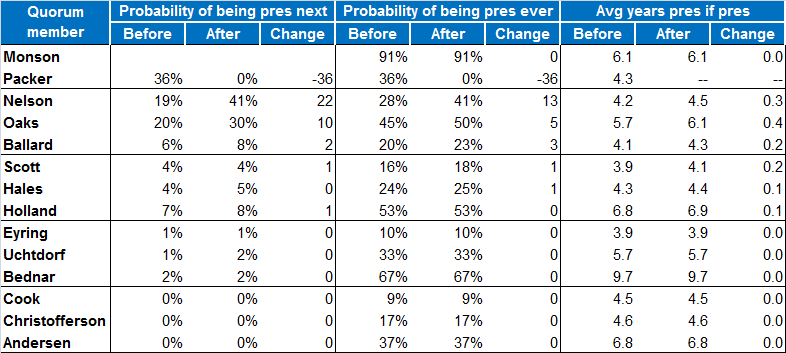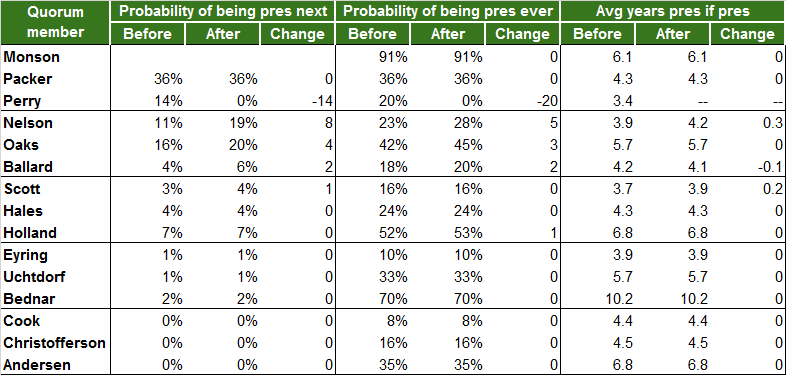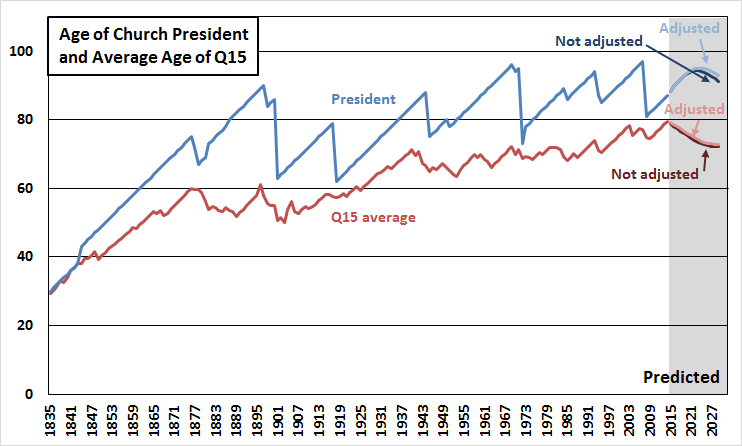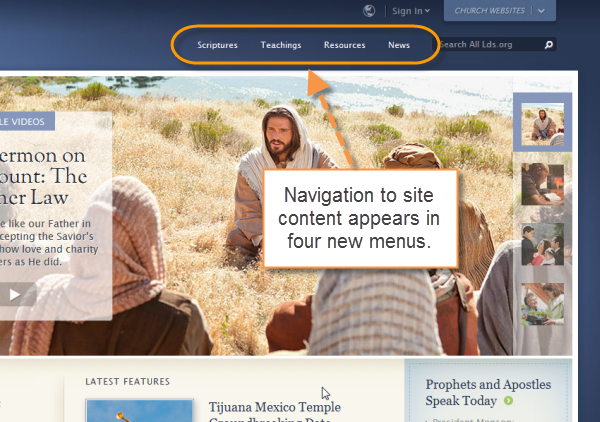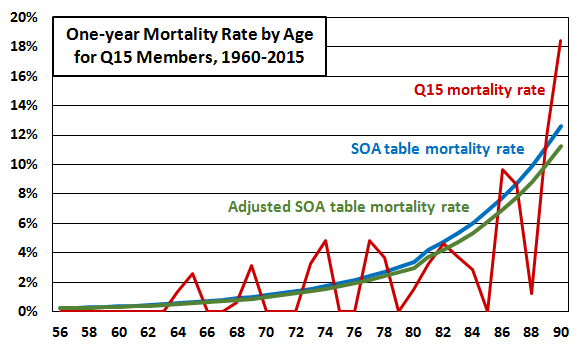I used to be one of the admins for an internet community that dealt with mental health issues. A lot of people in that community had dealt with abuse, and one of our goals was to keep it a safe environment for them. So we asked people to use trigger warnings when they brought up certain topics. It seemed perfectly reasonable to me. But while we did our best to enforce this policy, inevitably people ended up reading stuff that was triggering. And we emphasized that while we did what we could, ultimately it was their responsibility to learn to take care of themselves when that happened. Read More
Maybe the sea change has already happened.
It makes the most sense for Mormon theology if gay people don’t really exist. Read More
The People Behind the Abstractions
Early in our blogging years, a memorable incident involved one of my sisters sharing a personal experience. Another blogger came by to inform her that she could not have had the experience she reported. Why not? Because he had in his mind a neat system of how life worked, and her experience didn’t fit his system.
There is a tendency that troubles me in some popular LDS theological discourse to make theology into nothing more than an intellectual game. Don’t get me wrong; I think theological speculation can be quite interesting. But I think we lose something vital when it gets disconnected from the actual experience of living human beings. Read More
Contemplative Spaces
When I was at the University of Notre Dame, one of my favorite spots on campus was the Grotto, a small replica of the French Grotto of Our Lady of Lourdes. It was a small cave built of rock and filled with candles, and you could go there anytime, day or night, for prayer and reflection. I found it invaluable as a respite from some of the turbulence of my life. And I often reflected upon the fact that there was nothing similar at the other religious university I attended, that BYU seemed a model of efficiency but had no place on its campus for religious contemplation. Read More
Church President Probability Changes with President Packer’s Death
President Boyd K. Packer died on Friday at the age of 90. As I did when Elder Perry died, I thought it would be interesting to look at how this changes the probabilities of becoming Church President for the other members of the Q15
Here are their probabilities and average predicted years of being President before and after President Packer’s death. These come from the simulation I posted about a few months ago where I used a mortality table to run 1000 scenarios and see in how many each Q15 member would become Church President.
Same-Sex Marriage and Respecting Gay People
While I disagree with the church’s position on same-sex marriage, I don’t think it’s fair to assume that those who hold that position are simply evil homophobes bent on ruining the lives of gay people. My observation is that this opposition largely comes not from a particular animosity toward gay people—though that certainly may play a role at times—but from the fact that the contemporary church heavily emphasizes obedience and the importance of following the prophet. For Latter-day Saints who equate faithfulness with a willingness to strictly comply with the instructions of General Authorities, the question of same-sex marriage is simply not up for debate. Read More
From the archives: Elder Oaks Shows Us the Way Forward
A Mormon Voyage
In his brief history of India’s geography, Land of the Seven Rivers, Sanjeev Sanyal describes how India’s maritime prowess fell into decline beginning at the end of the twelfth century.
Indian merchants had once been explorers and risk-takers who criss-crossed the oceans in their stitched ships. They could be found in large numbers in ports from the Persian Gulf to China…Suddenly…they almost all disappeared.
What happened? Read More
Practicing Polygamy Versus Being Polygamous
How do we describe Mormon polygamy? I’ve often seen it said that 19th century Mormons “practiced” polygamy. For example, here’s President Hinckley on Larry King Live in 1998:
The figures I have are from — between two percent and five percent of our people were involved in [polygamy]. It was a very limited practice; carefully safeguarded. In 1890, that practice was discontinued.
There’s lots to criticize here, but what I’m concerned with is his use of the word “practice.” The word is used to minimize how central polygamy was, to demote it to just a minor incidental thing that some Church members did.
Mainstream Christian and LDS Feminism
This is a basic overview of feminist theological issues. I have a vague memory that I wrote it for a specific purpose, but I don’t remember what. In any case, I found it hiding in the depths of our queue, so I figured that I’d might as well blog it.
Though it’s not my particular specialty, in the course of my studies I’ve encountered a fair amount of Christian feminist theology. As I’ve thought about the various issues raised by feminist theologians, a recurring question for me has been that of to what extent and in what ways these issues are applicable in an LDS context. In comparison to mainstream Christian teachings, how might LDS beliefs either be supportive of, or pose challenges to, feminist ideals? Here I’d like to look at a few distinctive aspects of LDS teachings in this context. Read More
The Covenant Keeper’s Guide to Attending Church While on Vacation
You may have heard that it has been said by them of old time that covenant keepers will attend the full three-hour block of Sunday church meetings, even while on vacation. But I say unto you that that’s not nearly enough. Simply attending the three-hour block is for slothful, lukewarm covenant breakers who were clearly less valiant in the pre-existence. If you want to demonstrate that you’re a true covenant keeper, you’ll be sure to do the following while on vacation:
Church President Probability Changes with Elder Perry’s Death
Elder L. Tom Perry died on May 30th at the age of 92. I’m sure you won’t be surprised to learn that one question that I immediately wondered about on hearing the news was how this would affect the other Q15 members’ probabilities of becoming Church President.
Here are their probabilities and average predicted years of being President before and after Elder Perry’s death. These come from the simulation I posted about a couple of months ago where I used a mortality table to run 1000 scenarios and see in how many each Q15 member would become Church President.
Quote . . . Close Quote
I make the Sunday bulletins for my ward. I typically put a quote from a scripture or a Church leader that’s related to the theme of the sacrament meeting on the front. I often look for quotes from Church leaders by looking through recent Conference talks on related topics. Recently while I was doing this, I was reading a talk given by a member of a general auxiliary presidency, and I was struck by how much of her talk was made up of quotes of other sources. This reminded me of David Evans’s excellent post at T&S a few months ago where he looked at which speakers in Conference quote which types of sources. One of his findings was that higher-authority speakers quoted less from high authority sources than did lower-authority speakers.
What I wondered is whether higher-authority speakers quote other sources in general less than lower-authority speakers, regardless of the level of authority of the sources being quoted. An advantage of this question is that it didn’t require me to figure out authority levels of sources. Instead, I could just count words in talks and count how many of the words were in quotes.
I got data from all the talks in the last ten Conferences (October 2010 – April 2015). For each talk, I noted the speaker’s calling, the number of words in the talk, and the number of words in the talk that were part of a quote. Here are results by calling group.
| Position | Talks | Percent quotes |
|---|---|---|
| First Presidency | 88 | 14.8% |
| Quorum of the Twelve | 118 | 21.8% |
| Quorums of Seventy | 99 | 21.5% |
| Other – men | 19 | 20.8% |
| Other – women | 50 | 24.1% |
A Mother There or Multiple Mothers There? A look at whether GA statements about Heavenly Mother leave the door open for polygamy
I’ve always thought that a big positive of the Proclamation on the Family is that it mentions Heavenly Mother. Or to be more precise, it mentions Heavenly Parents. Here’s a quote from the section where they’re brought up:
All human beings—male and female—are created in the image of God. Each is a beloved spirit son or daughter of heavenly parents, and, as such, each has a divine nature and destiny.
I have always read “heavenly parents” here to mean a heavenly couple: Heavenly Father and Heavenly Mother. But I was part of an online discussion recently in which Nancy Ross (who you might know from the papers she has co-written on Mormon feminism) pointed out that the wording here is completely compatible with the possibility of a polygamous Heavenly Father married to many Heavenly Mothers. “Heavenly parents” could be two (as I’ve always read it) or it could be 50 or 10001. Another participant in the discussion, Melissa Mayhew (who you may know from her blogging as Rune at Feminist Mormon Housewives), suggested that it would be interesting to look at other statements GAs have made about Heavenly Mother to see if they’re also compatible with a multiple-Heavenly Mother reading. I thought that was a great idea, so that’s what I’ll be doing in this post.
Alzheimer’s Prevalence in the First Presidency and the Quorum of the Twelve
How many of the fifteen men in the First Presidency and the Quorum of the Twelve are currently suffering from Alzheimer’s disease? Of course I don’t know the answer to this question. I can give you an estimate, though. Since I’ve been crunching numbers recently to predict which Q15 members might become Church President, I have all these data on their ages and life expectancies lying around, and given that age is a strong predictor of Alzheimer’s, I thought it would be an interesting exercise to match up the age data with an Alzheimer’s prevalence table to see what proportion of the quorum might suffer from it in the past, present, and future.
The major data sources I used are (1) ldsfacts.net for birth, calling, and death dates for historical Q15 member ages, (2) the simulations I did for my post last month on predicting who will become Church President, for future Q15 member ages, and (3) this paper from the journal Alzheimer’s and Dementia for the Alzheimer’s and dementia prevalence rates. If you’re interested, I’ve described the process I followed in more detail at the end of this post.
Here’s a graph showing the average age of the Q15 and the age of the Church President from 1835 to 2014 (taken at the end of each year), and predicted ages for the Q15 and for the Church President for the next 15 years. I calculated predicted ages in two ways, one using the SOA mortality table that I used for my post last month about predicting which Q15 members would become Church President (labeled “not adjusted” in the graph, with darker colored lines), and the other (labeled “adjusted,” with lighter colored lines) with the mortality rates in the SOA table multiplied by 0.89 because I found in analyses for another post that this provided better fit to actual historical mortality rates of Q15 members.
She Shall Be an Ensign: A history of the Church of Jesus Christ of Latter-day Saints, told through the lives of its women.
Ardis Parshall, who you probably know as the author of the Mormon history blog Keepapitchinin, is planning to write a history of the Church told through the lives of women. She is asking for support through a Kickstarter campaign. I believe this is important work because I think the book will serve as a great counterweight to the overwhelmingly male-narrated and male-focused histories we currently tell in the Church. I hope it will help both women and men to have a broader vision of what women have done in the Church, and as consequence a broader vision of what women might be doing now and in the future. I have made a pledge, and I’m posting to ask you to also consider pledging. For a pledge of $10 or more, you’ll get a copy of the ebook version of the book, and for a pledge of $25 or more, you’ll get a hard copy.
Placement of Scriptures vs. Conference in Menus at LDS.org
Last week, the Church rolled out a redesigned version of the navigation menus at lds.org. The new menus rearranged links to parts of the site in order to make it easier for site visitors to find what we’re looking for.
One change in particular that seems unrelated to usability caught my eye, though. In the old menus, scriptures appeared in their own menu, and General Conference was in a menu labeled “Teachings.” Here’s a screenshot that shows the old menus. I’m sorry it doesn’t show General Conference under “Teachings,” as the old menus aren’t available anymore so I can’t take a new screenshot. I’ll just have to ask you to trust me that it was there. Also note that the callout calls the menus “new” because this image is from 2012, when the old menus were introduced.
A Look at Conference Speakers’ Favorite Verses of Scripture
I thought it might be fun to look at which speakers in General Conference are most fond of quoting which particular verses of scripture. If you’re thinking you’ve seen me blog about this before, you’re right. It’s just that in my previous posts, I’ve only looked at the level of book of scripture, but now I’m getting all the way down to the verse level. I apologize in advance; I don’t have any interesting hypotheses to examine here. This is another post where I’m just looking at some data descriptively and saying, “Isn’t this cool?”
I took scripture reference data from the LDS Scripture Citation Index. I used the current version of their site and not the new beta version because it was easier for me to pull data from the current version. Unfortunately, this means that what I have is only updated through 2013. The Conference data begins in 1942.
The table below lists the top five verses cited for speakers in Conference since 1942. I’ve limited it to showing top fives for two groups of people: Q15 members who have at least 500 total verses cited, and female auxiliary leaders who have at least 100 total verses cited. Many of the speakers have a tie in their #5 spot, so I’ve extended the table to show all tied verses, except in a few cases where it would have made the table ridiculously long (e.g., Julie B. Beck has a 25-way tie at #5). I’ve also included a brief quote or summary note on each verse to help jog your memory for verses that are less well-known, and I’ve linked each verse reference to the scriptures at lds.org so you can go read them in full if you’re interested.
Predicting Who Will Be Church President: Fit of Actuarial Mortality Table to Historical Data
Last month, I wrote a post where I used a mortality table and the current ages of the First Presidency and Quorum of the Twelve to see who among them would be most likely to become Church President. One question that was raised on the post and in some Facebook discussions was how well that mortality table matched up to historical mortality rates of Q15 members. In this post, I’ll try to answer that question.
I looked at historical data from January 1960 to April 2014. Each month1, for each current Q15 member, I noted two pieces of information: his age at the beginning of the month, and whether he was still living one year later. When I aggregated all the data together, they made an empirical mortality table. For any age that at least one Q15 member during that time period lived to, the proportion of such members who died within one year was the empirical mortality rate. Of course, there’s more data for the table at some ages than others, as few Q15 members during this time period were as young as their forties, but many have been in their sixties, seventies, and eighties.
Here’s a graph showing the mortality rate for Q15 members (in red), along with the mortality rate for the Society of Actuaries mortality table I used (in blue). I included only ages for which I had at least 120 person-month observations (or 10 person-years).
Deep Doctrine
“Deep doctrine” is one of the phrases I most dislike in Mormonism. It’s usually used with reference to questions like the location of Kolob, the Lost Ten Tribes, the role of other planets in the Plan of Salvation, the characteristics of different phases of existence, the meaning of various symbols in the book of Revelation, and so on and so forth.
If people want to spend their time exploring such subjects, I have no objection. I have plenty of my own strange interests. What I dislike, however, is the framework in which these topics are “deeper” than more central teachings, or that they are for the spiritually sophisticated. “Deep” all too often gets used as a synonym for “esoteric.” And one might ask, all right then, what are the “shallow” doctrines? Faith, repentance, the atonement? Are those doctrines that you grasp before moving on to the more advanced ones? Something seems more than a little off in such a model. Read More
